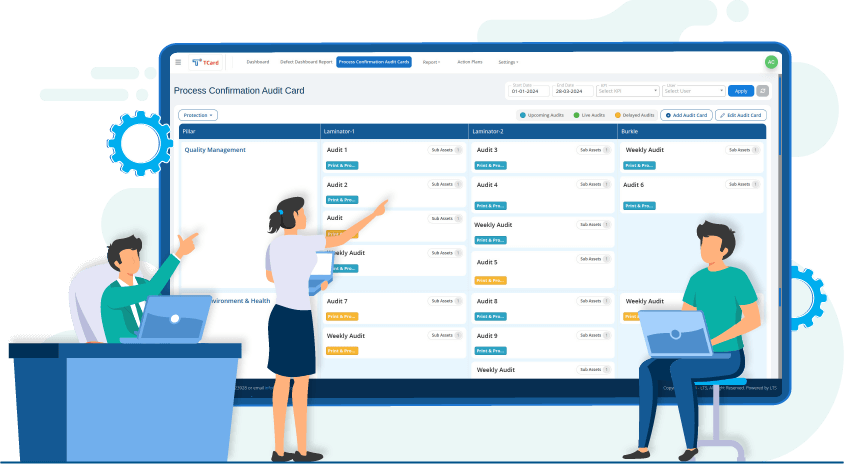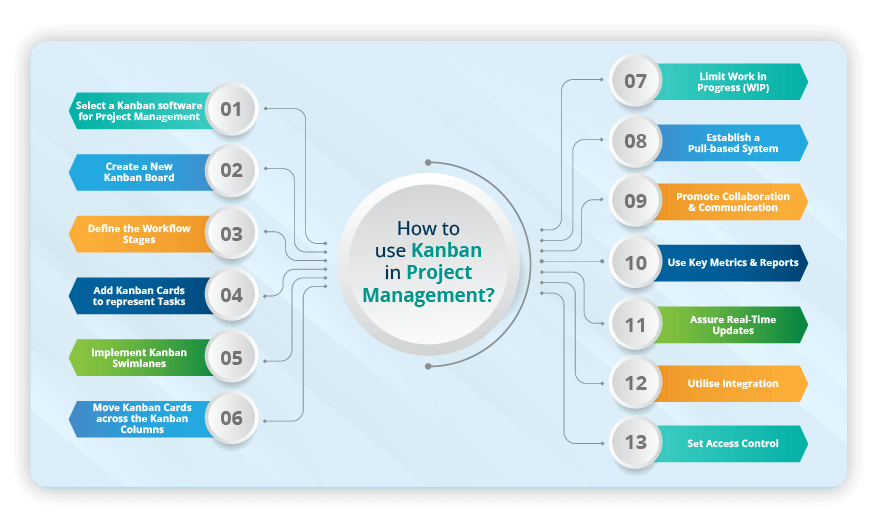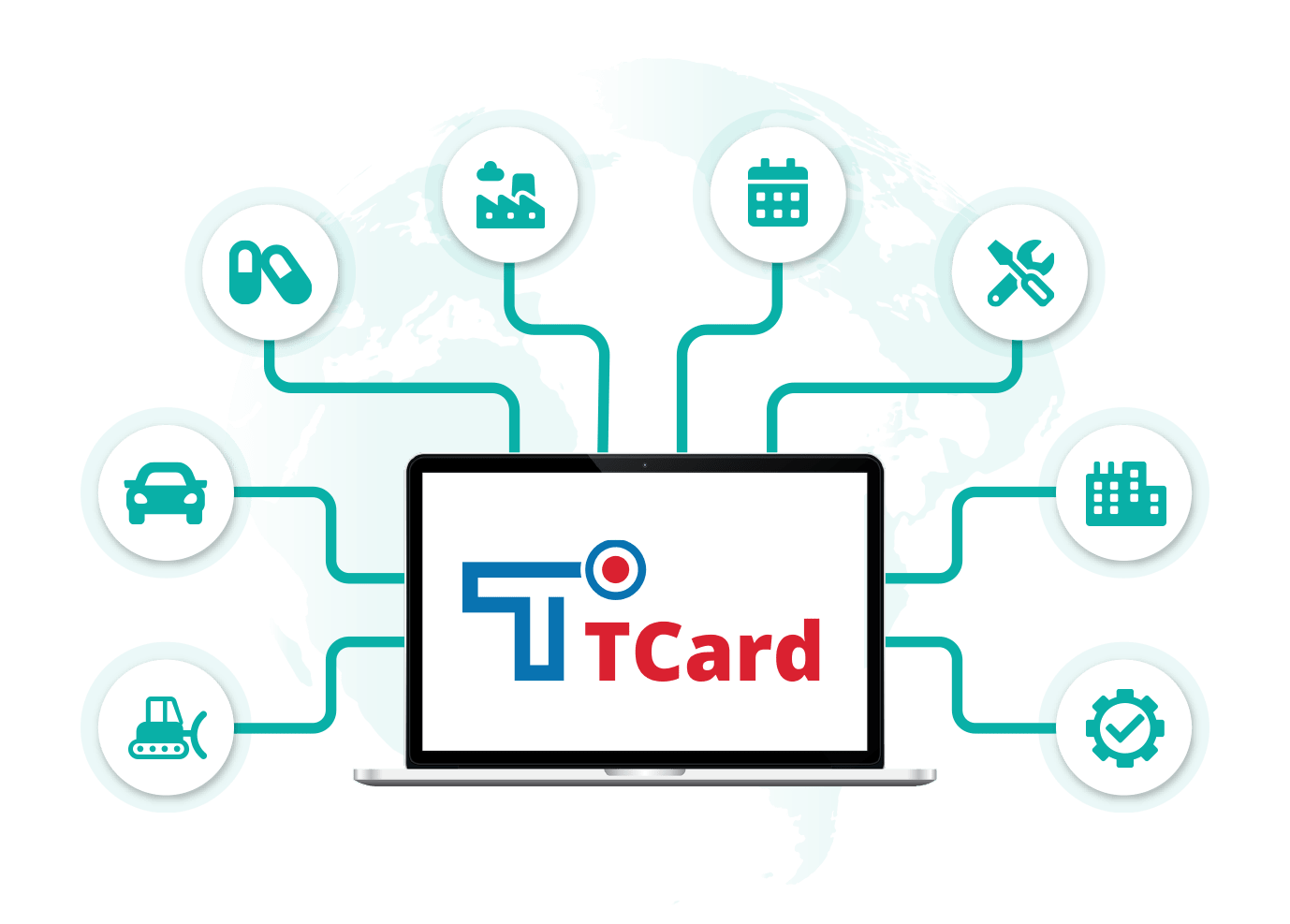Kanban Project Management: An Ultimate Guide
Kanban project management employs Kanban boards for continuous workflow optimisation to enhance productivity, efficiency, and team collaboration.
Start Free Trial Watch VideoContents
- What is Kanban Project Management?
- Key components of a Kanban Board assisting in Project Management
- How does Kanban differ from other Project Management Methodologies?
- How does Kanban help in Project Management?
- How does Kanban facilitate Task Prioritisation?
- Why are WIP Limits important in Kanban Project Management?
- How to use Kanban in Project Management?
- Portfolio Kanban
- How does Kanban handle changes and adaptations in Project Requirements?
- What are some common pitfalls to avoid when implementing Kanban for Project Management?
- How does Kanban support Remote or Distributed Teams?
- Best Kanban Practices for effective Project Management
- How does Kanban contribute to improved Team Efficiency and Productivity?
- How does Kanban help generate Project Status Reports based on workflow?
- Kanban Project Management Examples
What is Kanban Project Management?

Kanban project management is a unique and effective approach to project management, where teams use a Kanban board to visualise, manage, and track work processes in real-time. Initially derived from the Toyota Production System, Kanban has expanded beyond manufacturing to software development and other industries. This project management tool emphasises continuous improvement, helps to visualise work, limits Work-in-Progress (WIP), and maximises efficiency (or flow).
The core Kanban principles guide its implementation and usage within teams and organisations:
- Start with existing processes and practices: The Kanban method focuses on the current state of organisational workflows and processes. Instead of imposing radical changes, it encourages teams to start with their existing practices and gradually evolve them.
- Make small, incremental changes: The Kanban system advocates incremental improvements rather than large-scale transformations. Teams identify inefficiencies and improvement areas and then gradually implement change management strategies to avoid disruption and resistance.
- Respect current processes and responsibilities: When Kanban is integrated into project management, it respects the expertise and roles of individuals within the organisation. It recognises that people are familiar with their workflows and processes, and their insights are valuable for driving improvement.
- Encourage leadership at all levels: The Kanban tool encourages leadership and decision-making at all levels of the organisation. Team members are empowered to make decisions regarding their work processes, fostering a culture of ownership, collaboration, and accountability.
Key components of a Kanban Board assisting in Project Management
David Anderson, the pioneer of Kanban method for teamwork management identified five components of Kanban boards: Visual Signals, Kanban Columns, Work-in-Progress limits, a Commitment point, and a Delivery point. However, a Kanban Swimlane also offers significant advantages in project management and categorisation.
- Visual Signals: Visual signals are cues, often represented by Kanban cards on the Kanban board, indicating the status or nature of a task or work item. These signals help team members quickly understand the state of work and identify priorities.
- Kanban Columns: Kanban columns represent different stages or tasks in the workflow, such as "To Do," "In Progress," and "Done." Each column visually depicts the status of work items and helps track progress in real-time.
- Work-in-Progress (WIP) Limits: WIP limits are constraints on the number of tasks or work items allowed in each Kanban board column simultaneously. WIP limits prevent overloading and promote flow by encouraging teams to focus on completing existing tasks before starting new ones.
- Commitment Point: The commitment point marks the stage at which work items are committed to the team's workload. It represents the beginning of the workflow and signifies the point at which tasks are selected for execution.
- Delivery Point: The delivery point indicates the final stage of the workflow where completed work items are delivered or released to stakeholders or customers. It marks the completion of tasks and signifies that they have been successfully delivered.
- Kanban Swimlanes: Kanban swimlanes are horizontal sections or lanes on the Kanban board that categorise tasks or work items based on different criteria, such as priority, team member, or type of work. Swimlanes help organise and visualise work items within the workflow, facilitating better prioritisation and coordination.
How does Kanban differ from other Project Management Methodologies?
Among various project management frameworks, Kanban may be confused with similar methodologies. Here's how Kanban contrasts with other project management methodologies.
- Kanban vs Agile: While Agile is a broader methodology emphasising iterative development and customer collaboration, Kanban is a specific approach for visualising and managing workflow. Agile focuses on adaptability and customer feedback, while Kanban view emphasises continuous improvement and workflow optimisation.
- Kanban vs Scrum: Scrum is a framework with predefined roles and events that emphasises time-boxed iterations known as sprints. On the other hand, Kanban focuses on visualising and limiting Work in Progress (WIP). Scrumban combines Scrum and Kanban elements, allowing for workflow management flexibility.
- Kanban vs Waterfall: Waterfall is a traditional, linear project management methodology where each phase must be completed before proceeding to the next. Kanban is iterative and allows continuous delivery, focusing on incremental improvements and adapting to changing requirements. Compared to the rigid structure of a waterfall, Kanban promotes flexibility and responsiveness.
How does Kanban help in Project Management?
Kanban view offers several benefits in project management. The Kanban method helps project managers visualise their team's workflow on easy-to-use Kanban boards, facilitating project planning, scheduling, and tracking throughout the project lifecycle. Here's why project managers use Kanban for project management:
- Visual Workflow Management: By visualising tasks on a Kanban board, teams can prioritise tasks, set due dates, and monitor real-time progress, enabling better project planning and resource scheduling. Team members can easily add, update, and change task status on the Kanban board, ensuring alignment with project goals and timelines.
- Identify Bottlenecks: Teams can quickly identify bottlenecks and areas where work gets stuck (blocked tasks) by visualising the workflow on the Kanban board. Hence, teams can address issues promptly and keep the project moving smoothly through stages.
- Enhanced Flexibility and Adaptability: Kanban allows teams to adapt to changing project priorities, requirements, and circumstances without disrupting workflow or timelines.
- Reduced Work Overload: Setting Work-in-Progress (WIP) limits helps prevent work overload and maintains focus on completing tasks effectively within the project timelines.
- Improved Collaboration and Communication: Kanban promotes collaboration and communication among team members by providing a centralised platform for task management and updates.
- Enables Continuous Improvement: Kanban fosters a culture of continuous improvement by encouraging teams to reflect on their processes, identify improvement areas, and make incremental changes over time.
- Increased Accountability and Transparency: With tasks clearly defined and visible on the Kanban board, team members are accountable for their responsibilities, and project progress is transparent to all stakeholders.
- Enhanced Customer Satisfaction: Kanban ultimately leads to higher customer satisfaction by enabling teams to deliver work more efficiently and effectively.
How does Kanban facilitate Task Prioritisation?
Kanban facilitates task prioritisation within project plans by visualising workflow stages and limiting Work in Progress (WIP). Project managers utilise Kanban boards to categorise deliverables into phases, such as backlog, in progress, and completed. With tasks represented as cards on the Kanban board, teams can quickly identify bottlenecks and allocate resources accordingly. By moving cards through the workflow, project managers can prioritise tasks based on immediate needs and project goals. Kanban's visual nature fosters transparency and flexibility, enabling teams to adapt priorities as project requirements evolve, thus enhancing project management effectiveness.
Why are WIP Limits important in Kanban Project Management?
WIP (Work in Progress) limits play a crucial role in Kanban project management, enhancing throughput and minimising the accumulation of partially completed work. By constraining the number of tasks in progress, teams can concentrate on a more manageable workload, fostering a culture of completing tasks. This focus on completion is essential for effective project execution. Moreover, WIP limits reveal blockers and bottlenecks, making them visible to the team. This transparency enables prompt identification and resolution of impediments, contributing to smoother project workflows and improved overall efficiency.
How to use Kanban in Project Management?

Knowing how to set up the Kanban project management board and its benefits can help you implement it in your organisation.
- Select a Kanban software for Project Management: Choose a suitable digital Kanban board tool or platform that aligns with the project requirements and team preferences.
- Create a New Kanban Board: Initiate the project by creating a new Kanban board for managing tasks and workflows.
- Define the Workflow Stages: Establish distinct workflow stages on the Kanban board, such as "To Do," "In Progress," and "Done," reflecting the project's specific process.
- Add Kanban Cards to represent Tasks: Populate the Kanban board with cards representing each task containing relevant details like descriptions, due dates, and assignees.
- Implement Kanban Swimlanes: Kanban Swimlanes visually groups various work types on the same board and facilitates the organisation of similar tasks.
- Move Kanban Cards across the Kanban Columns: As tasks progress through the project workflow, move corresponding Kanban cards across the Kanban columns to reflect their current status and stage of completion.
- Limit Work in Progress (WIP): Set the WIP limits for each workflow stage to prevent overloading and maintain a manageable workload, fostering focus and efficiency.
- Establish a Pull-based System: Adopt a pull system where team members pull tasks from the backlog into the workflow based on capacity and priority, promoting flexibility and workflow automation.
- Promote Collaboration and Communication: Use the Kanban board software as a central hub for discussing tasks, sharing updates, and addressing issues to encourage collaboration and communication among team members.
- Assure Real-Time Updates: Ensure the Kanban board is regularly updated with real-time progress and status changes, providing visibility and transparency to all stakeholders.
- Use Key Metrics and Reports: Utilise Kanban tools' analytics and reporting capabilities to monitor lead time, cycle time, and other key performance metrics. These features enable you to track the duration of tasks from initiation to completion, identify bottlenecks in the workflow, and derive actionable insights for process improvement.
- Utilise Integration: Integrate the Kanban software with other project management tools and platforms to streamline data sharing, enhance interoperability, and improve workflow efficiency.
- Set Access Control: Implement access control measures to regulate user permissions and ensure that sensitive project information remains secure and accessible only to authorised individuals.
Portfolio Kanban
Portfolio Kanban is a strategic approach that applies Kanban principles to portfolio management, aligning projects with organisational objectives. It enables the visualisation and management of multiple projects within a portfolio, facilitating prioritisation, resource allocation, and progress tracking. By integrating Kanban boards at the portfolio level, stakeholders gain visibility into project plans, phases, and dependencies. Portfolio Kanban enhances project management by promoting transparency, optimising workflow processes, and facilitating adaptive decision-making based on real-time data. It allows organisations to effectively manage resources, balance priorities, and ensure the timely delivery of strategic initiatives, ultimately driving business success.
How does Kanban handle changes and adaptations in Project Requirements?
Kanban handles changes and adaptations in project requirements by fostering a flexible and responsive workflow. With Kanban boards visualising tasks and their statuses, teams can quickly identify evolving project needs and adjust priorities accordingly within project plans. As new requirements emerge or existing ones change, teams can easily reprioritise tasks, allocate resources, and adapt their workflow without disrupting ongoing work. This dynamic approach allows continuous improvement and ensures the projects are aligned with stakeholder expectations and evolving business objectives throughout the project lifecycle.
What are some common pitfalls to avoid when implementing Kanban for Project Management?
- Overloading WIP limits: Avoid setting WIP limits too high, as it can lead to inefficiencies and bottlenecks.
- Lack of clear workflow definition: Ensure each workflow stage is well-defined to prevent confusion and mismanagement of tasks.
- Ignoring team collaboration: Foster open communication and collaboration among team members to prevent silos and promote shared understanding.
- Failure to monitor and adjust: Regularly monitor Kanban metrics and adapt the process to address emerging challenges and optimise workflow.
- Neglecting continuous improvement: Emphasise the importance of constant improvement to enhance project management practices and outcomes sustainably.
How does Kanban support Remote or Distributed Teams?
Kanban supports remote or virtual teams by providing a centralised platform for visualising tasks, fostering collaboration, and promoting transparency. Team members can access and update the task statuses from anywhere through online Kanban boards, facilitating real-time communication and alignment. Features such as task assignments, comments, and attachments enhance collaboration, while the visual nature of Kanban boards enables team members to grasp project progress at a glance. Additionally, digital Kanban tools often integrate with project management tools, further enhancing communication and coordination among remote team members. Kanban is a flexible and effective framework for managing projects in dispersed work environments, ensuring continuity and productivity regardless of team location.
Best Kanban Practices for effective Project Management
-
Visualise Workflow
- Use a Kanban board to represent tasks and their progress.
- Categorise work stages (e.g., To-Do, In-Progress, Done) for clear visibility.
-
Limit Work in Progress (WIP)
- Set WIP limits to prevent overloading team members.
- Enhance focus by completing existing tasks before taking on new ones.
-
Prioritise and Classify Tasks
- Assign priority levels to tasks for better organisation.
- Use colour-coded labels or tags to classify tasks by type or importance.
-
Manage Flow and Cycle Time
- Monitor and optimise the flow of tasks through the system.
- Analyse cycle time to identify bottlenecks and streamline processes.
-
Implement Feedback Loops
- Establish mechanisms for continuous feedback.
- Adapt the process based on feedback to improve efficiency.
-
Visualise Dependencies
- Identify and display task dependencies on the Kanban board.
- Anticipate and address potential bottlenecks caused by dependencies.
-
Implement a Pull System
- Adopt a pull-based approach to task assignment.
- Allow team members to pull tasks based on capacity and expertise.
How does Kanban contribute to improved Team Efficiency and Productivity?
Kanban significantly enhances team efficiency and productivity by visualising work, enabling teams to prioritise tasks, limit Work in Progress (WIP), and optimise workflow. Through continuous monitoring and adaptation, Kanban helps identify bottlenecks and streamline processes, improving cycle time and throughput. By fostering collaboration, encouraging feedback, and promoting a culture of continuous improvement, Kanban ensures teams remain agile and responsive to changing priorities and customer needs. Moreover, Personal Kanban extends these benefits to individuals, facilitating goal attainment and personal productivity through visual task management and WIP limits tailored to individual capacity and priorities.
How does Kanban help generate Project Status Reports based on workflow?
Kanban facilitates the generation of detailed project status reports by tracking time spent on different phases of the project workflow and assessing team efficiency. By capturing data on task progression and completion, Kanban enables the creation of cumulative graphs that illustrate workflow patterns over time. These reports provide valuable insights into project schedule adherence, team performance, and overall project timeline alignment with the project plan. Through Kanban's visualisation capabilities, project stakeholders can generate reports on a weekly, monthly, quarterly, or yearly basis, allowing for continuous monitoring and timely adjustments to ensure project success and delivery according to plan.
Kanban Project Management Examples
-
Kanban Project Management in the Manufacturing Industry
- In the manufacturing industry, Kanban boards are instrumental in managing workflows efficiently. Let's take an automobile manufacturing plant as an example.
- The Kanban board would represent different stages of production, from raw materials to finished products. Each Kanban column on the board could represent a specific phase, like "Raw Materials", "In Production", "Quality Control", and "Finished Goods".
- Kanban Cards on the board signify different components or assemblies needed for the production process. As work progresses, cards move across the board, indicating the status of each item.
- Kanban helps minimise inventory levels by signalling when more materials are needed based on consumption rates. This ensures a smooth production flow without overstocking or understocking.
- It also enhances communication between different departments, such as procurement, production, and quality control, ensuring timely delivery and high-quality outputs.
-
Kanban Project Management in Software Development
- Kanban boards streamline the development process in software development by visualising tasks and their progress.
- A software development team may have columns on its Kanban board representing phases like "Backlog," "Ready for Development," "In Progress," "Testing," and "Completed."
- A Kanban card represents each task on the Kanban Board. Developers pull tasks from the backlog based on priority and capacity, and the cards move across the Kanban board as they work on them.
- The Kanban board helps teams maintain a steady pace of development, identify bottlenecks, and allocate resources effectively. Additionally, it enables continuous delivery by promoting the completion of smaller, incremental tasks, leading to faster feedback loops and improved customer satisfaction.
-
Kanban Project Management in the Construction Industry
- In the construction industry, Kanban boards aid in managing complex projects, which include multiple stakeholders and dependencies.
- A construction project's Kanban board could consist of Kanban columns like "Pre-Construction Planning", "Permitting", "Material Procurement", "Construction", and "Inspection".
- Kanban cards on the board represent tasks like obtaining permits, ordering materials, or completing specific construction phases.
- As tasks progress, cards move through the workflow, providing real-time visibility into project status. Kanban helps construction teams coordinate activities, manage subcontractors, and track progress against project milestones.
- By visualising the construction process, Kanban enables project managers to identify potential delays, allocate resources efficiently, and ensure projects are completed promptly within budget.

